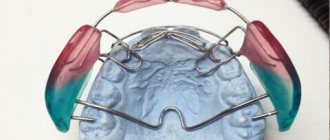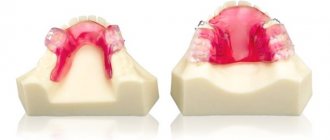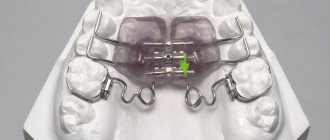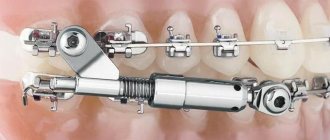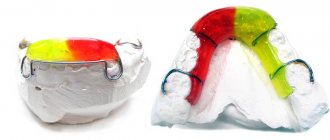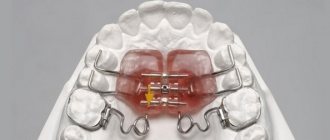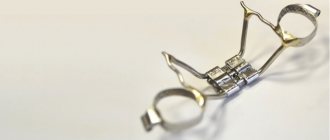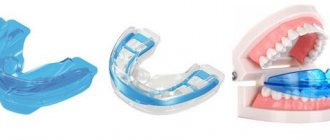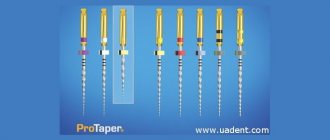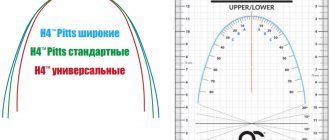The Frenkel appliance is one of the types of orthodontic appliances created to eliminate the problems of malocclusion, uneven teeth, and developmental deformities of the jaws in children.
This device allows parents from an early age to begin correcting congenital pathological disorders of the dentition (its use is allowed for children from 3-4 years old).
Features of the device design
The basis of the removable two-jaw apparatus is:
- complex metal frame;
- side (cheek) shields;
- lip pelota;
- loops for securing incisors and canines.
The frame is made of thin elastic wire, up to 1 mm in diameter, with three arcs:
- lingual;
- palatal;
- vestibular.
The arches are connected to plates made of plastic (less often metal); if necessary, screws and springs are additionally used to speed up the movement of certain teeth.
Manufacturing process
The device is made on the basis of a two-jaw cast. The latter reflects the nature of the location of all teeth, alveolar processes and folds near the tongue. The final model is fixed in such a way that it forms the correct bite.
Based on the cast, the doctor determines the location of the side shields. These elements should not fit tightly to the dentition and alveolar processes. During the modeling process, wax is poured into the area where the side panels and caps will be located. The thickness of the former does not exceed 2.5 mm, the latter – 3 mm.
A special laboratory is engaged in manufacturing the base of the device. Metal arches are adjusted in the presence of the patient. The work on creating the Frenkel apparatus will be completed by polishing and grinding the plastic structural elements.
Operating principle of the Frenkel apparatus
Most orthodontic structures have a mechanical effect on the dentition.
Frenkel developed an absolutely unique technique based on a functional effect on the regulation of muscle tone, with its help you can achieve the following results:
- reducing pressure on the cheeks and lips on the jaw in problem areas;
- positive effect on the activation of functions and natural functioning of the muscular tissues of the oral cavity;
- normalization of nasal breathing;
- the device promotes the desired position of the tongue, closing of the lips and thereby ensures the harmonious development and growth of the jaws of young patients.
Appliances for correcting open bite
The choice of design depends on the complexity of the bite pathology itself, as well as on the individual characteristics of the patient. In addition, the price of such a device is important, because not everyone can afford expensive options. However, often more budget options turn out to be very effective in treating malocclusion.
Records
The plate is the simplest and most affordable design option for correcting an open bite. It can be prescribed to both adults and children. This device is a plate that consists of two parts fastened with a special screw. Both parts are attached to the teeth depending on the location of the bite deformation. After this, the doctor tightens the screw so that the pressure exerted by the plate on the teeth changes their position in the desired direction.
Trainers
Trainers are special silicone mouthguards for correcting open bites. They are made individually from a pre-made impression. They can be worn both during the day and at night.
Bracket systems
Braces are considered one of the most effective methods for correcting an open bite. With their help, you can most accurately correct the movement of each individual tooth, aligning its location.
Today there is a wide variety of braces systems. They differ in materials, appearance and price. You can choose design options that will be completely invisible in the mouth and will not cause discomfort when communicating with others.
Andresen-Goipl apparatus
This type of design is called an activator or plate. It consists of two parts that interlock with each other. As a result, it is possible to restore the function of the facial and chewing muscles, thereby activating normal jaw growth and correcting the bite.
Frenkel apparatus
This device is aimed at reducing pressure on the teeth from the tongue and cheeks. In this way, it is possible to restore the normal position of the lips, which begin to close together, and as a result, a natural correction of the open bite occurs.
Indications for use of the Frenkel apparatus
The effective period for the treatment of children's dental pathologies is considered to be the time of their active growth (4 - 12 years).
An orthodontic appliance is used for the following pathologies:
- distal bite (strong development of the upper jaw);
- mesial bite (pushing forward of the lower teeth);
- open bite (the lower and upper dentitions do not meet, a gap is formed);
- neutral bite (insufficient development of alveolar processes);
- narrowing of the dentition;
- twisted teeth.
Complications of open bite
Like any other dental pathology, an open bite can cause a number of complications. In addition to aesthetic defects, which can be expressed in a constantly open mouth, deformation of the jaw, chin and other parts of the face, this also concerns the functioning of internal organs. Especially in this case, the gastrointestinal tract suffers. Since a person with an open bite cannot fully chew food, especially hard food, it ends up in the stomach in this form. As a result, gastroenterological diseases may develop that will require serious and long-term treatment.
Another common complication is distortion of a person's speech. Since an open bite eliminates the barrier to the tongue, the opportunity for full articulation also disappears. In this regard, it becomes simply impossible to pronounce some sounds.
Important! It is necessary to remember that without correcting the malocclusion itself, it will not be possible to improve speech. Therefore, you should not waste time on speech therapists and other specialists, but it is better to immediately contact a professional orthodontist.
Examination before physiotherapy
The appearance of the slightest signs of abnormal development of teeth in a child obliges parents to seek advice from an orthodontist.
After a visual examination, the doctor will suggest:
- take an x-ray or orthopantomogram of the upper and lower jaw;
- cure carious teeth and inflammatory processes in the oral cavity, if any.
Based on the images, the doctor will determine the type of pathology and prescribe treatment with the appropriate type of device design to eliminate the defect.
Causes
The causes of open bite can be divided into prenatal and postnatal. The first group includes the following:
- various unfavorable hereditary factors;
- infectious and somatic diseases suffered by the woman;
- bad habits and unbalanced diet of a pregnant woman;
- severe toxicosis.
All these factors can influence the process of bite formation in primary and permanent teeth. In this case, more serious concomitant pathologies may develop, such as cleft lip, deformation of the entire jaw, etc. Therefore, when identifying any malocclusion, it is important to conduct a comprehensive examination.
An open bite may develop in the postnatal period due to internal or external factors. In the first case, we are talking about a lack of certain microelements in the body, as well as a violation of metabolic processes.
Another common cause of malocclusion is that the child has problems with nasal breathing. In this regard, he begins to systematically breathe through his mouth, getting used to keeping it open. If parents notice such features, they should check the structure of the nasopharynx, especially the nasal septum, as soon as possible and begin treatment. Otherwise, the child may develop not only an open bite, but also other jaw pathologies.
The group of external factors includes the following:
- the child’s habit of biting nails or other foreign objects, for example, toys, pen caps, etc.;
- thumb sucking during the eruption of baby teeth;
- frequent protruding of the tongue between the teeth with the mouth open.
Often in these cases, the very form of the malocclusion begins to resemble the outline of the object that the child held in the mouth - a finger, a toy, etc.
Types of Frenkel apparatus
Different pathologies require different effects on the patient’s dental apparatus. There are four types of this design:
- FR - I is used to eliminate signs of distal occlusion with protrusion of the frontal teeth of the upper jaw, and with narrowing of the dentition. They consist of palatal and lingual arches, attached with upper and lower pelota. The cheek shields are connected to the lower pads using brackets. It is located in the oral cavity so that the shields do not come into contact with the alveolar ridge.
- FR-II is used to correct excessive inclination of the upper incisors (retrusion). It differs from the first type in the type of loop capes on the fangs and the presence of double pelotes. The shields are in close contact with the dentition and the crest of the alveoli. Made from transparent material.
- FR - III eliminates progeny (excessive development of the lower jaw). The design feature is the absence of lower pelotes and the presence of a vestibular arch.
- FR - IV corrects open bite, eliminates the reasons that hinder the development of the lower jaw. There are pads for the lower lip, a vestibular arch for the upper row, and metal pads. The device also helps to separate the bite.
Duration of treatment
The timing of correction using the Frenkel orthodontic apparatus depends on the Patient’s compliance with all recommendations and regular visits to the doctor. The greatest effectiveness is observed when installed at the age of 11-14 years, that is, before the formation of a permanent position of the teeth. It takes about 4-8 months for pronounced anomalies, and the result is permanent; the functionality and aesthetics of the series are fully restored. In case of serious pathologies and a mature bite, treatment may take at least a year and a half. But the first results become noticeable after two to four months. During the entire correction period, the structure is replaced up to three times.
Price
The price of the Frenkel apparatus depends on the following factors:
- condition of the oral cavity, degree of defect;
- ongoing diagnostic and preparatory activities;
- the type of device selected for correction;
- installation features, the need for additional actions.
To make a calculation, you must contact our clinic and undergo a preliminary examination and diagnosis. Based on the data obtained, the doctor will determine the treatment tactics and name the cost of the correction.
About Us
Magenta Dental Clinic is a modern orthodontic clinic that provides treatment services and elimination of a number of dental defects. We provide our Patients with the following benefits:
- use of certified materials and equipment;
- services of highly qualified doctors;
- treatment effectiveness;
- individual approach and comfortable conditions for each Patient;
- affordable price.
To make an appointment, leave a request on the website, call by phone, send a request by email. Our doctors are ready to advise you at any time and provide qualified assistance in accordance with the highest modern requirements.
Rules and terms for using the Frenkel apparatus
In order for the treatment to be effective, the following rules and deadlines must be observed:
- The Frenkel apparatus is used at night and for a short time during the day (2-3 hours). During daytime treatment, it is forbidden to talk or eat food.
- It is imperative to carry out daily hygiene procedures for the oral cavity and orthodontic structure to avoid the development of caries.
- The duration of the treatment period is from 8 months to 1.5 years.
- Due to the intensive development of the child’s dental apparatus, the device changes 3-4 times during treatment.
Wearing rules and care
Before starting therapy, the orthodontist gives detailed recommendations on the use and care of the regulator. The device should only be worn while sleeping because you should not chew or talk while wearing it. To enhance the effect, you can wear it for an additional three hours during the day. It does not cause discomfort to small patients (unlike many other orthodontic structures). Another advantage is the rapid adaptation period.
During the treatment process, you will need to change the product 2-3 times, because the child’s jaws are actively growing, and the effectiveness of the correction may decrease.
The device must be cleaned regularly to avoid the accumulation of bacteria on its surface. If you neglect proper care, this is fraught with the development of caries.
Results after therapy with the Frenkel apparatus
The use of the Frenkel apparatus in eliminating deviations in the development of the dentition gives a good effect:
- eliminates the need for a surgical solution to the problem in later stages of the disease;
- Speech defects caused by dental pathologies are corrected.
- children get rid of bad habits (holding a finger, a pencil in the mouth).
- the effectiveness of treatment has a positive effect not only on the physical condition of the child, but also improves his appearance and psychological mood.
The Frenkel apparatus is actively used by orthodontists, is popular among patients and is considered a worthy alternative to the braces system.
Price
The cost of manufacturing the Frenkel apparatus varies between 7,000–18,000 rubles .
Its price directly depends on the type of design:
- You will have to spend about 7 thousand to manufacture the first type of regulator.
- Ordering a Frenkel apparatus of the second and third types will cost 13 thousand rubles.
- Manufacturing the fourth type will cost about 18 thousand rubles.
This cost does not include the amount for treatment, including payment for services for preparing the dentition and correcting the apparatus.
The total cost of installation including manufacturing can cost from 13 thousand to 50 thousand rubles . The final price will depend not only on the type of structure, but also on the condition of the dentition and periodontal tissue.
